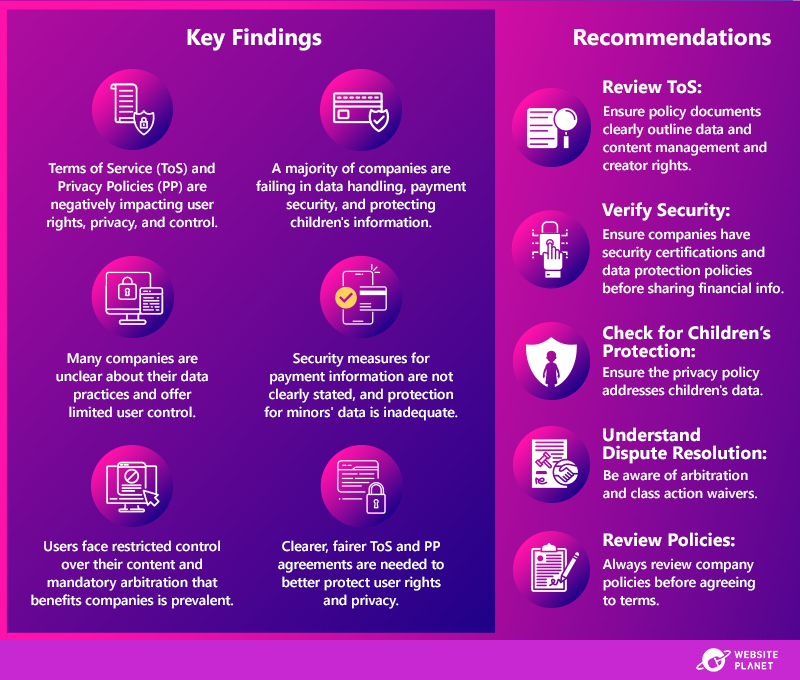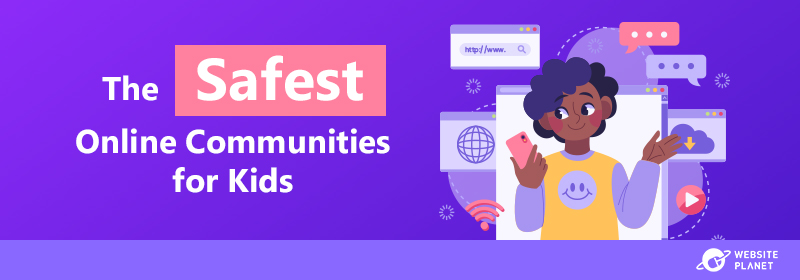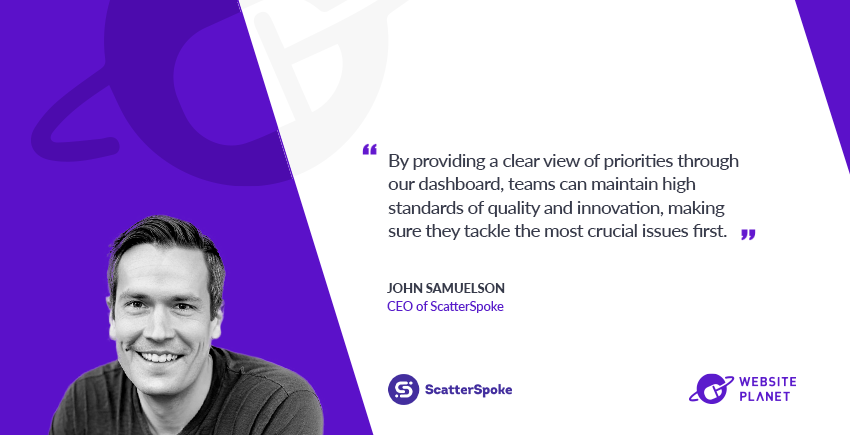Inside this Article
![Copy of [Update Outline] - Business blogging Stats in 2021](https://dt2sdf0db8zob.cloudfront.net/wp-content/uploads/2023/06/copy-of-update-outline---business-blogging-stats-in-2021-1.png) Business blogging has been an important part of marketing campaigns for years. Based on this list of 50+ business blogging statistics, blog content shows no signs of slowing down in 2025.
We’ve gathered some of the latest research, compiling a selection of statistics on everything from the impact blogging can have on your business to marketing trends and the crucial elements you need to include for a blog to really stand out.
So sit back, relax, grab a piece of paper and a pen. Here are 50+ business blogging statistics you need to know in 2025.
Business blogging has been an important part of marketing campaigns for years. Based on this list of 50+ business blogging statistics, blog content shows no signs of slowing down in 2025.
We’ve gathered some of the latest research, compiling a selection of statistics on everything from the impact blogging can have on your business to marketing trends and the crucial elements you need to include for a blog to really stand out.
So sit back, relax, grab a piece of paper and a pen. Here are 50+ business blogging statistics you need to know in 2025.
Business Blogging Industry Overview
We’ll kick things off with a general overview of blogging, and more specifically “business blogging.” Where do readers go to read blogs? How popular are blogs? And where are the majority of bloggers located?1. How Many Blogs Are There Online?
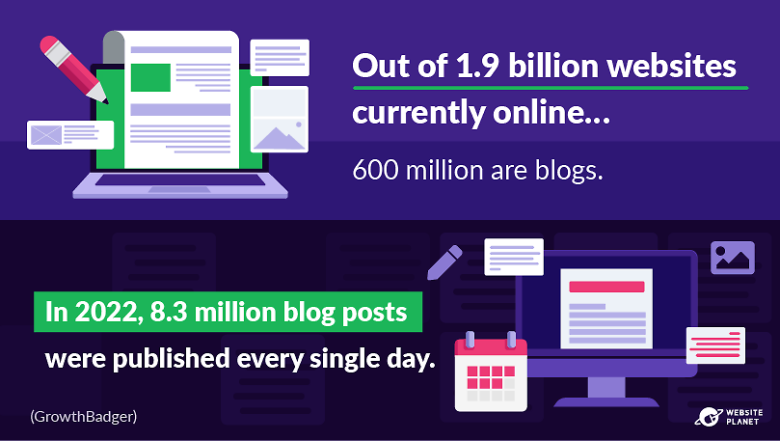 Blogging is more popular than ever in 2025. People just love to consume loads of content, which is why 32% of websites on the internet are blogs.
Blogging is one of the best ways to grow your business and drive results. Everyone is doing it, with millions of new articles posted on a daily basis.
If you were under any illusions about how competitive the business blogging world really is, hopefully, this statistic will show you how hard it can be to write a great blog that stands out.
Blogging is more popular than ever in 2025. People just love to consume loads of content, which is why 32% of websites on the internet are blogs.
Blogging is one of the best ways to grow your business and drive results. Everyone is doing it, with millions of new articles posted on a daily basis.
If you were under any illusions about how competitive the business blogging world really is, hopefully, this statistic will show you how hard it can be to write a great blog that stands out.
2. How Many Businesses Have a Blog?
 We’ve seen a sharp rise in the number of successful businesses that blog in recent years, which is surprising given that blogging’s been around for quite a while now.
Nonetheless, over three-quarters of top businesses have a blog. That owes to the popularity of content marketing right now, amid a recent surge in the number of users online and engaging in e-commerce.
We’ve seen a sharp rise in the number of successful businesses that blog in recent years, which is surprising given that blogging’s been around for quite a while now.
Nonetheless, over three-quarters of top businesses have a blog. That owes to the popularity of content marketing right now, amid a recent surge in the number of users online and engaging in e-commerce.
3. Which CMPs Do Bloggers Use?
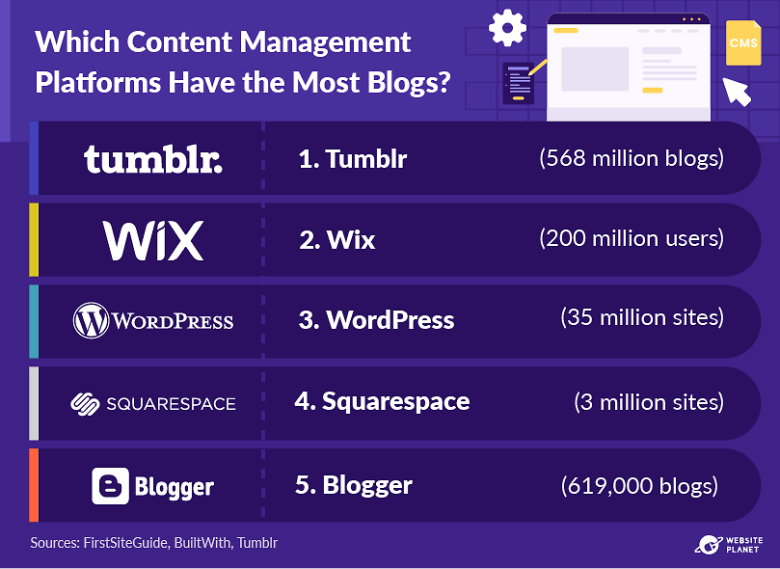 So, where are people posting their blogs?
The results show that the biggest content management platforms aren’t always the best places to host your blog. WordPress dominates the content management market with a 65% share, yet Tumblr is by far the number one place for bloggers.
WordPress still hosts a significant number of blogs, but is even outperformed by Wix, which hosts 200 million blogs in 2025.
So, where are people posting their blogs?
The results show that the biggest content management platforms aren’t always the best places to host your blog. WordPress dominates the content management market with a 65% share, yet Tumblr is by far the number one place for bloggers.
WordPress still hosts a significant number of blogs, but is even outperformed by Wix, which hosts 200 million blogs in 2025.
4. Where Are Bloggers Located?
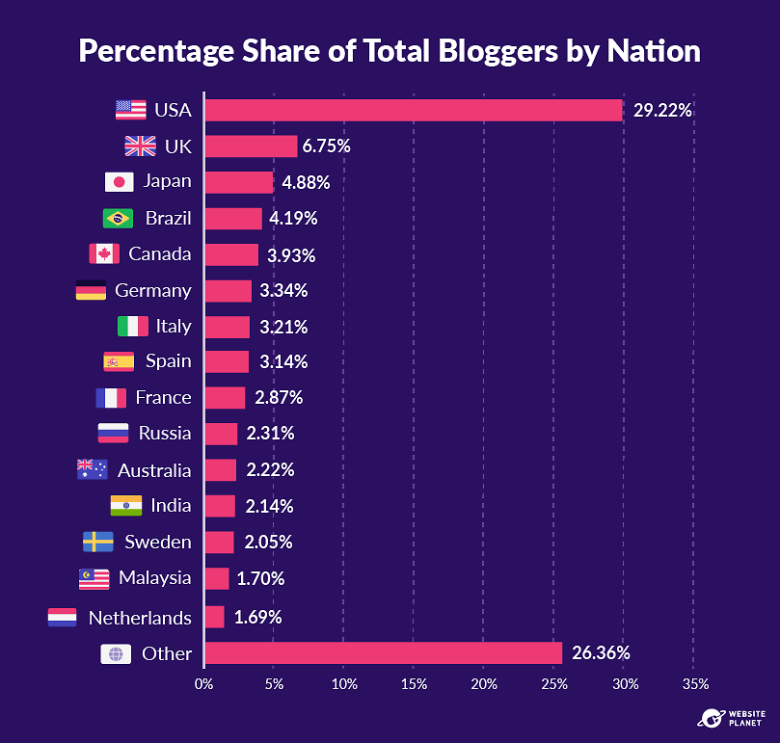 The USA is home to the most business bloggers, and by some distance.
The US blogging industry has seen a sharp rise over the last decade. There are now roughly 32 million bloggers located in the United States, an increase of 10 million since 2014. That means nearly 10% of US citizens are blogging!
The United Kingdom (a much smaller nation) is second on the list, accounting for nearly 7% of all bloggers around the world. The popularity of blogging in these 2 countries explains why English is the most popular blogging language. Over 70% of WordPress blogs are written in English.
The USA is home to the most business bloggers, and by some distance.
The US blogging industry has seen a sharp rise over the last decade. There are now roughly 32 million bloggers located in the United States, an increase of 10 million since 2014. That means nearly 10% of US citizens are blogging!
The United Kingdom (a much smaller nation) is second on the list, accounting for nearly 7% of all bloggers around the world. The popularity of blogging in these 2 countries explains why English is the most popular blogging language. Over 70% of WordPress blogs are written in English.
5. How Old Are Bloggers?
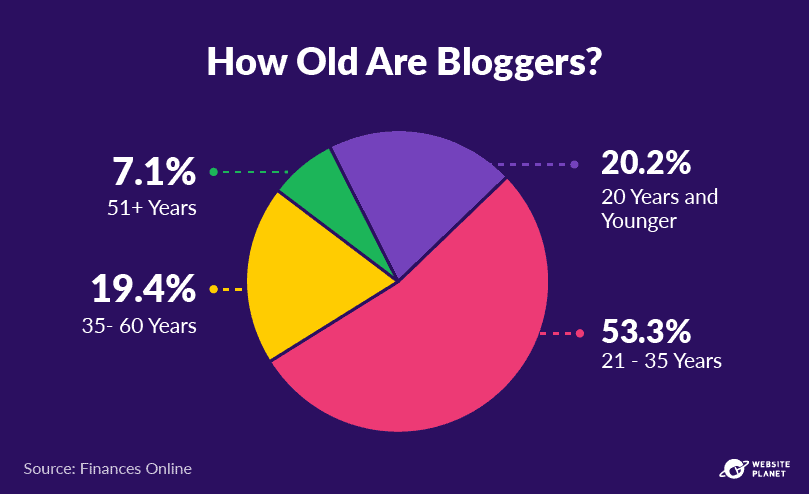 The majority of bloggers are aged between 21 and 35 years old. 20% of bloggers are 20 years old and younger, while around 19% of bloggers are slightly older, at 35-60 years old. Just 7% of bloggers are 51 and older.
Men also blog slightly more often than women. 50.9% of bloggers are male, whereas 49.1% are female.
The majority of bloggers are aged between 21 and 35 years old. 20% of bloggers are 20 years old and younger, while around 19% of bloggers are slightly older, at 35-60 years old. Just 7% of bloggers are 51 and older.
Men also blog slightly more often than women. 50.9% of bloggers are male, whereas 49.1% are female.
6. How Much Do Bloggers Earn?
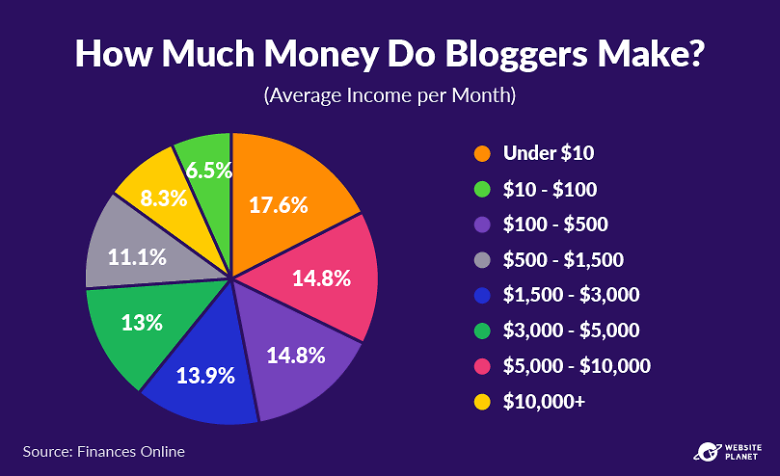 If you’re interested in blogging professionally, you’ll want to consider how much bloggers earn for their trouble. For a large portion of bloggers, the returns aren’t great.
With around a quarter of bloggers earning $100 or less, the above chart does tell you that it’s not always easy to make money from your blog.
It has to be said that not all bloggers are creating content for monetary gains or business purposes. However, the monetary gains are significant for a sizable portion of bloggers, and this group will likely make a return on their investment and then some, given the extra business that blogging can generate.
If you’re interested in blogging professionally, you’ll want to consider how much bloggers earn for their trouble. For a large portion of bloggers, the returns aren’t great.
With around a quarter of bloggers earning $100 or less, the above chart does tell you that it’s not always easy to make money from your blog.
It has to be said that not all bloggers are creating content for monetary gains or business purposes. However, the monetary gains are significant for a sizable portion of bloggers, and this group will likely make a return on their investment and then some, given the extra business that blogging can generate.
7. How Popular Are Blogs?
 People love reading blog content. Whether it’s an informative “how to” or a more entertaining piece, you need to give people what they want to see if you want your business to capitalize on blogging’s potential.
According to Business 2 Community, 60% of consumers enjoy reading content from brands.
The vast majority of consumers would also much rather read a business’ blog content than something that feels like marketing material. According to a report from SEOtribunal, 70-80% of search engine users will flat-out ignore paid-for search listings in favor of organic content.
People love reading blog content. Whether it’s an informative “how to” or a more entertaining piece, you need to give people what they want to see if you want your business to capitalize on blogging’s potential.
According to Business 2 Community, 60% of consumers enjoy reading content from brands.
The vast majority of consumers would also much rather read a business’ blog content than something that feels like marketing material. According to a report from SEOtribunal, 70-80% of search engine users will flat-out ignore paid-for search listings in favor of organic content.
8. How Old Are Blog Readers?
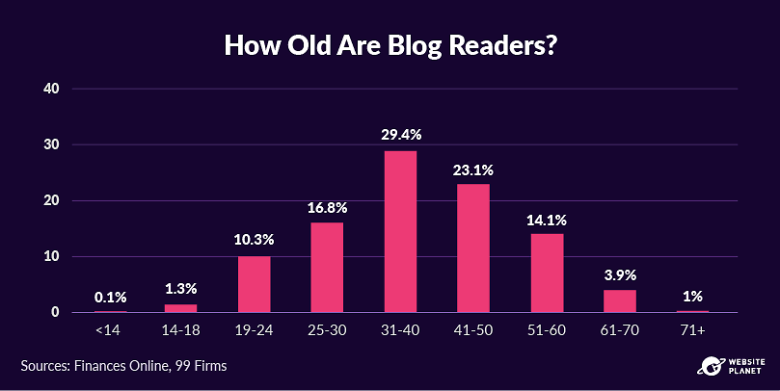 Identifying the target audience of your blog is important if you want to make an impact with your business’ content.
Your demographic will depend on your industry and company. But in general, the majority of blog readers are aged 31-40 (29.4%), and another 23.1% are aged 41-50.
So, people who read blogs are commonly aged between 30 and 50. If it suits your product or service, you could think about targeting this age range with your business’ blog content.
Identifying the target audience of your blog is important if you want to make an impact with your business’ content.
Your demographic will depend on your industry and company. But in general, the majority of blog readers are aged 31-40 (29.4%), and another 23.1% are aged 41-50.
So, people who read blogs are commonly aged between 30 and 50. If it suits your product or service, you could think about targeting this age range with your business’ blog content.
9. Most People Read Blogs on Mobile
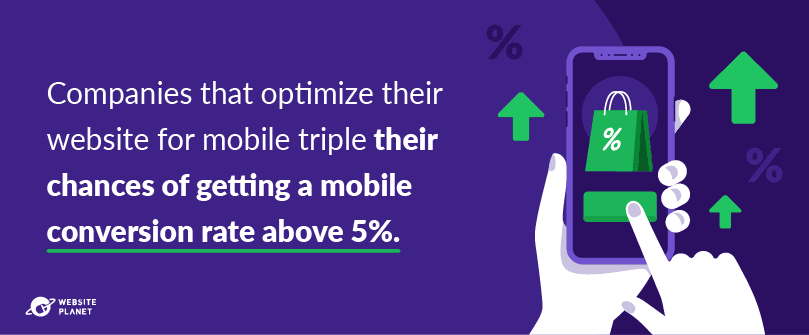 Online consumption is trending toward mobile users, and the way people read your blog posts will be no different.
As of February 2023, 60.04% of internet traffic comes from people using mobile devices. That’s increased dramatically over the last few years; in 2015, that number was as low as 31.16%.
Bloggers should therefore optimize websites to meet the demands of the reader. Loads of people will be visiting your blog on a mobile device. If the layout is overly complicated and the content hard to read, you can expect to lose a large segment of potential readers.
Online consumption is trending toward mobile users, and the way people read your blog posts will be no different.
As of February 2023, 60.04% of internet traffic comes from people using mobile devices. That’s increased dramatically over the last few years; in 2015, that number was as low as 31.16%.
Bloggers should therefore optimize websites to meet the demands of the reader. Loads of people will be visiting your blog on a mobile device. If the layout is overly complicated and the content hard to read, you can expect to lose a large segment of potential readers.
The Benefits of a Blog for Your Business
Here, we’ll take a look at some of the benefits businesses can expect to see when they implement a functioning blog content strategy.10. Blogs Convert Website Visitors to Customers
 Blogs lead to buys. And why might that be?
Blogs offer businesses the opportunity to create a ton of value for the viewer. Informative content, in particular, can provide more happiness to the viewer than, say, a poster or advertisement.
When you show someone the value of your service, they are much more likely to buy a product from you. That’s why, whether B2B or B2C, viewers read blogs as part of their buying journey.
Blogs lead to buys. And why might that be?
Blogs offer businesses the opportunity to create a ton of value for the viewer. Informative content, in particular, can provide more happiness to the viewer than, say, a poster or advertisement.
When you show someone the value of your service, they are much more likely to buy a product from you. That’s why, whether B2B or B2C, viewers read blogs as part of their buying journey.
11. Blogs Boost Brand Awareness
 Great content spreads the word about your brand ethos, great service, and fantastic products.
That may not actually be the topic of each article you write. But if you do a good enough job, informative content will boost customer satisfaction while teaching customers about your brand in more ways than you can imagine.
Providing this kind of value is also a great way to forge long-term relationships with your customers.
And what do those long-term relationships lead to in the end? More readers and more sales.
Great content spreads the word about your brand ethos, great service, and fantastic products.
That may not actually be the topic of each article you write. But if you do a good enough job, informative content will boost customer satisfaction while teaching customers about your brand in more ways than you can imagine.
Providing this kind of value is also a great way to forge long-term relationships with your customers.
And what do those long-term relationships lead to in the end? More readers and more sales.
12. Blogs Boost Traffic
 Having a decent blog is going to drive traffic to your website, and this is one of the key ways in which a blog will promote successful results.
People can find blog content in a number of ways, including social media pages and organic searches. The point is, a blog is going to give people a reason to visit your site. They may not be interested in your products at first, but when they see a blog that helps them with something, they’re going to click through to see what it’s about.
By having more visitors to your site, you directly increase your chances of making a sale. That’s why blogging creates more “leads.”
Having a decent blog is going to drive traffic to your website, and this is one of the key ways in which a blog will promote successful results.
People can find blog content in a number of ways, including social media pages and organic searches. The point is, a blog is going to give people a reason to visit your site. They may not be interested in your products at first, but when they see a blog that helps them with something, they’re going to click through to see what it’s about.
By having more visitors to your site, you directly increase your chances of making a sale. That’s why blogging creates more “leads.”
13. Blogs Generate Significant Leads
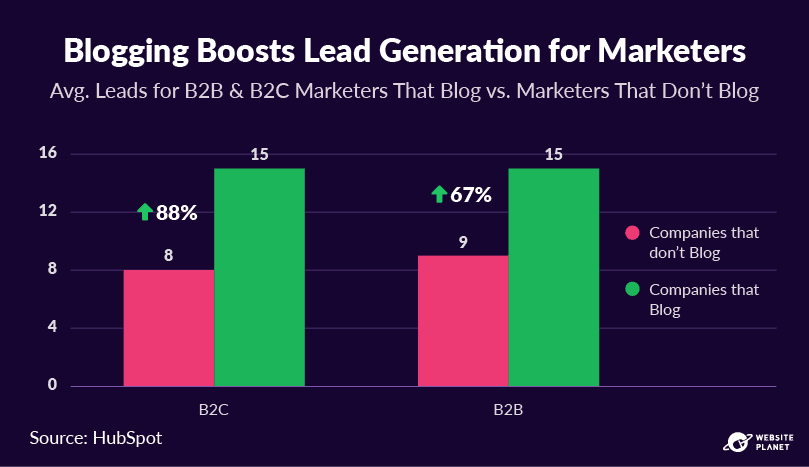 Blogging has a huge effect on lead generation in both B2B and B2C marketing.
When a business generates a “lead,” it means the company has come into contact with a potential customer. The increase in traffic that blogging creates becomes an increase in leads.
In B2C, bloggers see 88% more leads; in B2B, bloggers see 67% more leads.
What’s more, having a blog positively influences a business’ ability to grow its number of leads month-by-month. According to another piece of research by HubSpot, companies that blog can grow leads a whopping 126% faster than companies that don’t blog.
Blogging has a huge effect on lead generation in both B2B and B2C marketing.
When a business generates a “lead,” it means the company has come into contact with a potential customer. The increase in traffic that blogging creates becomes an increase in leads.
In B2C, bloggers see 88% more leads; in B2B, bloggers see 67% more leads.
What’s more, having a blog positively influences a business’ ability to grow its number of leads month-by-month. According to another piece of research by HubSpot, companies that blog can grow leads a whopping 126% faster than companies that don’t blog.
14. Blogs Get Backlinks
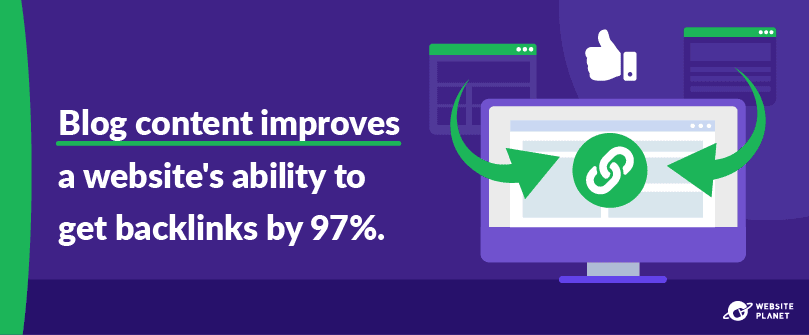 According to OptinMonster, blogs are ranked as the fifth most trusted source of information for online users. People trust great blog content, which is why they can generate so many backlinks to your website.
What’s the advantage of having backlinks? Having more backlinks not only brings more traffic onto your page from other sites, but it’s also invaluable for your website’s search engine optimization (SEO).
When other sites use your content and credit you as the source, it’s like a “vote of confidence” from one website to another. The trust others place in your content posits your brand’s page as “trustworthy” and “valuable.” In any search engine’s eyes, this is enough to place your page nearer the top of a user’s search results.
In this way, backlinks boost traffic, leads, and conversions on your site, so you definitely want to target backlinks with your content.
According to OptinMonster, blogs are ranked as the fifth most trusted source of information for online users. People trust great blog content, which is why they can generate so many backlinks to your website.
What’s the advantage of having backlinks? Having more backlinks not only brings more traffic onto your page from other sites, but it’s also invaluable for your website’s search engine optimization (SEO).
When other sites use your content and credit you as the source, it’s like a “vote of confidence” from one website to another. The trust others place in your content posits your brand’s page as “trustworthy” and “valuable.” In any search engine’s eyes, this is enough to place your page nearer the top of a user’s search results.
In this way, backlinks boost traffic, leads, and conversions on your site, so you definitely want to target backlinks with your content.
15. Blogs Help You Rank on Google
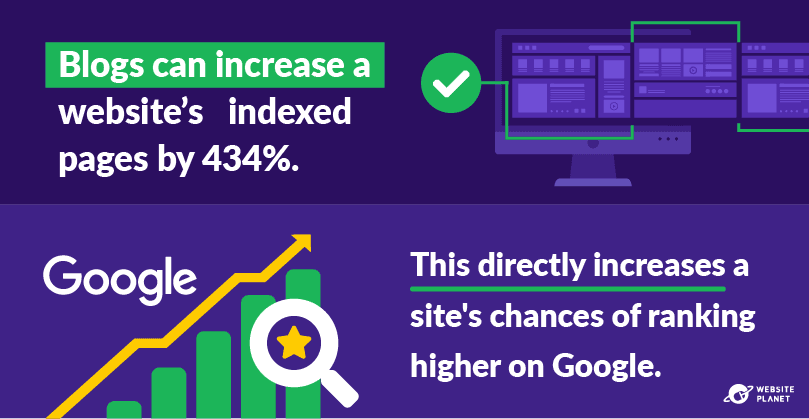 In more ways than one, blog content helps you rank higher on Google. And why wouldn’t you want to rank on Google? It’s favored by 90% of internet users after all!
Indexed pages are the pages on a website that a search engine has added to its database, either through discovering the page with bots or visiting the page at the user’s request.
Blogs promote over 400% more indexed pages from your business’ site, and they increase the number of indexed links by close to 100%. Having more of your pages featured on Google is crucial because it will help you rank higher in search results.
It’s certainly important to rank higher on Google. According to research from Chikita, 95% of people using Google to search never leave the engine’s first page of results, while nearly 50% of all clicks go to the top 3 search results (Ignite Visibility).
Getting a high rank in search results is important, then, if you want to boost traffic and improve performance for your business.
In more ways than one, blog content helps you rank higher on Google. And why wouldn’t you want to rank on Google? It’s favored by 90% of internet users after all!
Indexed pages are the pages on a website that a search engine has added to its database, either through discovering the page with bots or visiting the page at the user’s request.
Blogs promote over 400% more indexed pages from your business’ site, and they increase the number of indexed links by close to 100%. Having more of your pages featured on Google is crucial because it will help you rank higher in search results.
It’s certainly important to rank higher on Google. According to research from Chikita, 95% of people using Google to search never leave the engine’s first page of results, while nearly 50% of all clicks go to the top 3 search results (Ignite Visibility).
Getting a high rank in search results is important, then, if you want to boost traffic and improve performance for your business.
16. Blogs Provide Great ROI
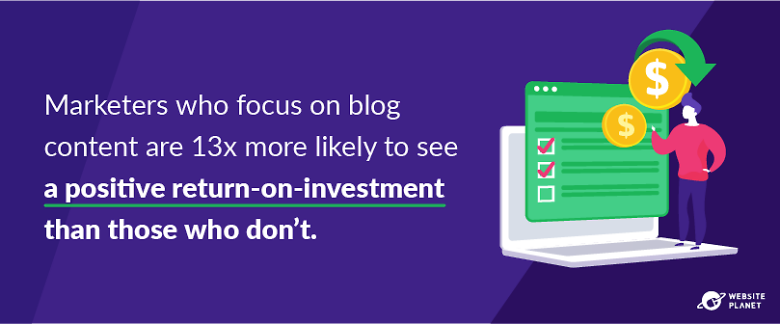 Blogging returns your investment.
Blogging is one of the cheapest forms of content marketing, yet it yields some of the best results. That’s why 82% of marketers say they see a positive ROI when they blog consistently (HubSpot).
Not only can you make good money through monetizing your content, but blogging also increases performance across a range of other factors. This is why business blogging is such a no-brainer.
Blogging returns your investment.
Blogging is one of the cheapest forms of content marketing, yet it yields some of the best results. That’s why 82% of marketers say they see a positive ROI when they blog consistently (HubSpot).
Not only can you make good money through monetizing your content, but blogging also increases performance across a range of other factors. This is why business blogging is such a no-brainer.
17. Blogs Support Other Marketing Channels
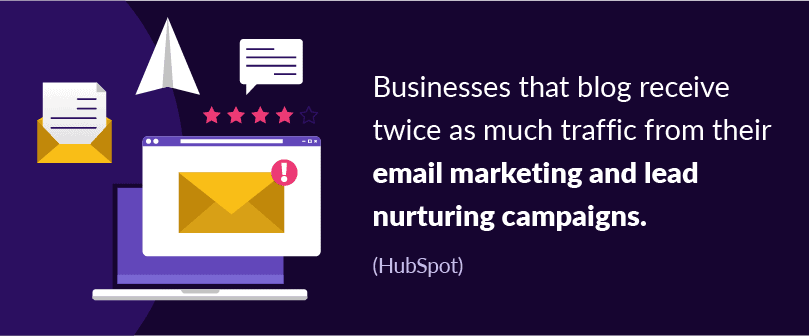 Ultimately, blog content supports your business across a range of other channels and distribution strategies.
Blogs increase the trustworthiness of your brand and page while providing a high level of value to the average viewer. That’s why, according to Demand Metric, 82% of users feel better about a brand after reading its blog content.
When consumers can touch base with your blog content to see what you’re about, they’re much more likely to be receptive to other marketing materials. This explains why companies who blog see improvements in email marketing and lead nurturing campaigns.
Ultimately, blog content supports your business across a range of other channels and distribution strategies.
Blogs increase the trustworthiness of your brand and page while providing a high level of value to the average viewer. That’s why, according to Demand Metric, 82% of users feel better about a brand after reading its blog content.
When consumers can touch base with your blog content to see what you’re about, they’re much more likely to be receptive to other marketing materials. This explains why companies who blog see improvements in email marketing and lead nurturing campaigns.
What Do Marketers & Bloggers Say?
What do bloggers and marketers have to say about all this? What are the current trends in business blogging? And what might these trends tell us about the business blogging landscape now and in the future? We discuss all that and more.18. Blogs Provide Measurable Results
 26% of bloggers in Orbit Media’s comprehensive survey believe blogging provides them with “strong marketing results.” Another 54% get “some results” from blogging, and around 20% are not completely satisfied with their blog.
The overwhelming opinion from bloggers is that the practice works, which explains why it’s used by the vast majority of marketers.
26% of bloggers in Orbit Media’s comprehensive survey believe blogging provides them with “strong marketing results.” Another 54% get “some results” from blogging, and around 20% are not completely satisfied with their blog.
The overwhelming opinion from bloggers is that the practice works, which explains why it’s used by the vast majority of marketers.
19. Marketers Love Blogs
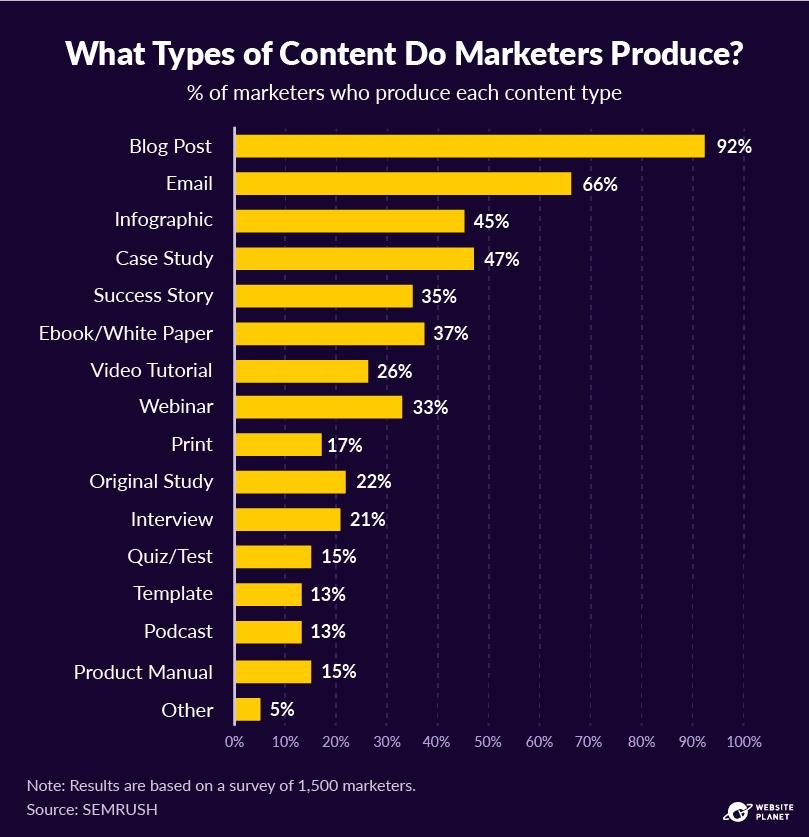 Blogging is such a crucial tool for businesses that 92% of marketers say they produce blog content.
Marketers rely on blog content as part of the sales funnel created by their marketing materials. It’s the sales funnel that drives any potential lead through a buyer journey, which explains why 90% of marketers feel blogging is an important part of their SEO strategy (TopRank).
Blogging is such a crucial tool for businesses that 92% of marketers say they produce blog content.
Marketers rely on blog content as part of the sales funnel created by their marketing materials. It’s the sales funnel that drives any potential lead through a buyer journey, which explains why 90% of marketers feel blogging is an important part of their SEO strategy (TopRank).
20. In-House Writers Are Common

Among all specialist positions in a marketing agency, “Writer/ContentCreator” is the most commonly employed part of a marketing team. Given the importance of blog content to marketers, this should come as no surprise. It points to the fact that there is always more content for a blogger to write — so why not employ one full time?
21. Writing Can Also Be Outsourced
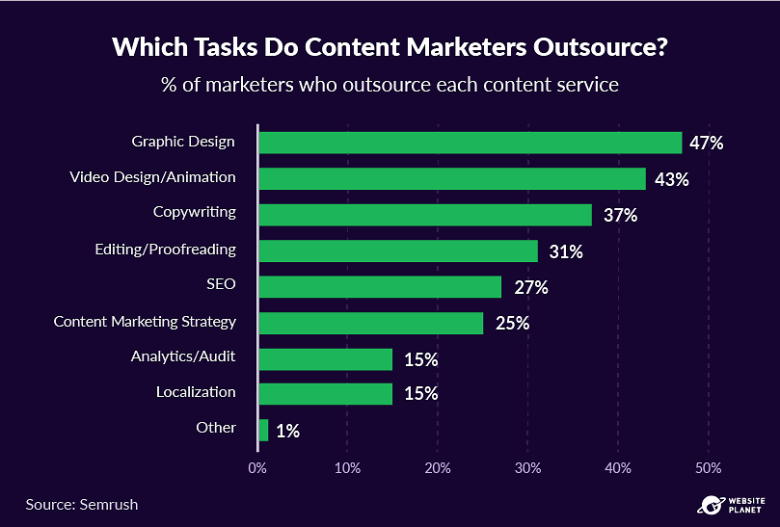 Over a third of marketers in Semrush’s survey outsource copywriting duties to freelancers. But why might a company do this?
There’s a huge demand for writing services right now, from blog posts to eBooks and case studies.
The success of blog writing and its importance to marketing agencies means marketers often need to outsource writing services to meet their targets.
Some organizations actually prefer to outsource writing for a couple of reasons. An increase in the size of the freelance workforce means there’s a greater depth of talent to choose from for any given project, while specialist roles are often cheaper to fill with a freelancer rather than a full-time employee.
Over a third of marketers in Semrush’s survey outsource copywriting duties to freelancers. But why might a company do this?
There’s a huge demand for writing services right now, from blog posts to eBooks and case studies.
The success of blog writing and its importance to marketing agencies means marketers often need to outsource writing services to meet their targets.
Some organizations actually prefer to outsource writing for a couple of reasons. An increase in the size of the freelance workforce means there’s a greater depth of talent to choose from for any given project, while specialist roles are often cheaper to fill with a freelancer rather than a full-time employee.
22. How Much Does Blog Content Cost?
 So, on average, how much does it cost to outsource content writing for a blog?
Research from GrowthBadger shows that the vast majority (82%) of low-income bloggers pay freelancers less than $100 to complete an article.
Bloggers with a higher income, including marketers and businesses, are far more likely to pay well for their blog content. 30% of high-income bloggers pay $100-$300 per article, while another 26% pay $300-$500. Around 20% of high-income bloggers pay between $500 and $1000 per article for blog content.
In the same survey, GrowthBadger found that the average high-income blogger pays 3.6X more money for an outsourced blog than low-income bloggers ($347 vs $96).
The results show that most bloggers are willing to pay for great content, which owes to the return-on-investment it can ultimately provide.
So, on average, how much does it cost to outsource content writing for a blog?
Research from GrowthBadger shows that the vast majority (82%) of low-income bloggers pay freelancers less than $100 to complete an article.
Bloggers with a higher income, including marketers and businesses, are far more likely to pay well for their blog content. 30% of high-income bloggers pay $100-$300 per article, while another 26% pay $300-$500. Around 20% of high-income bloggers pay between $500 and $1000 per article for blog content.
In the same survey, GrowthBadger found that the average high-income blogger pays 3.6X more money for an outsourced blog than low-income bloggers ($347 vs $96).
The results show that most bloggers are willing to pay for great content, which owes to the return-on-investment it can ultimately provide.
23. Which Type Of Blog Content Is Most Effective?
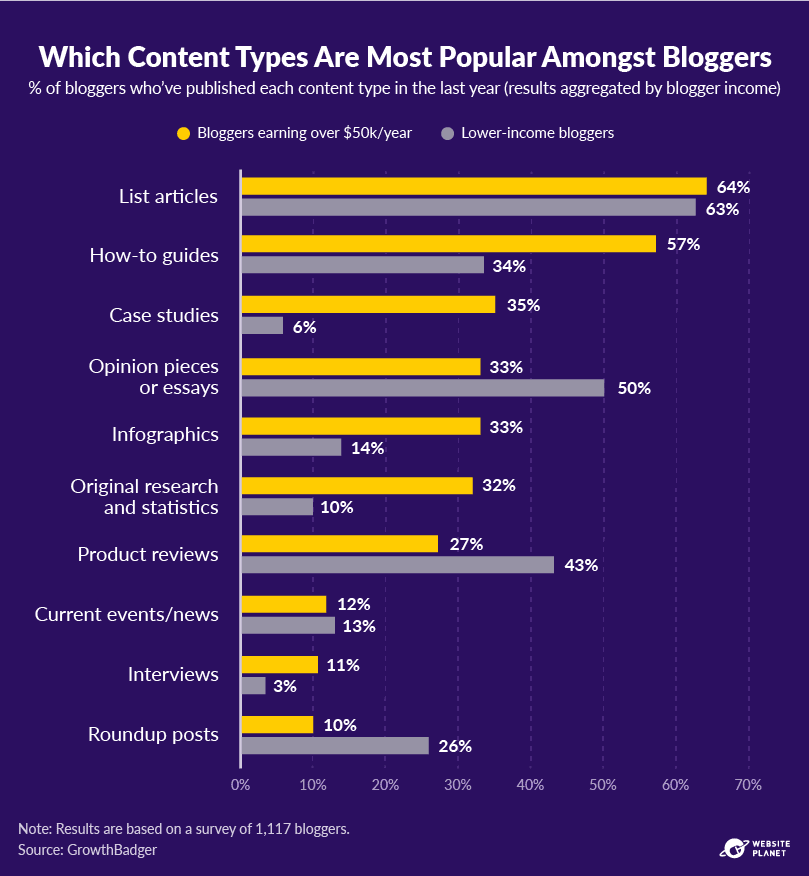 GrowthBadger’s survey asked bloggers which types of content they have produced in the last year.
“Opinion pieces” ranked as the fourth most popular content type, while “How-to” articles were the second most popular type of content. Listicles ranked number 1.
These results can be explained through another study from BuzzSumo, which ranked content types by the average number of shares they receive. In Buzzsumo’s study, listicles checked out as the second most shared content type overall, while “How-to” articles were the 3rd most shared type of content.
This seems to explain why marketers love these two types of blog content so much: they drive reach and engagement.
GrowthBadger’s survey asked bloggers which types of content they have produced in the last year.
“Opinion pieces” ranked as the fourth most popular content type, while “How-to” articles were the second most popular type of content. Listicles ranked number 1.
These results can be explained through another study from BuzzSumo, which ranked content types by the average number of shares they receive. In Buzzsumo’s study, listicles checked out as the second most shared content type overall, while “How-to” articles were the 3rd most shared type of content.
This seems to explain why marketers love these two types of blog content so much: they drive reach and engagement.
24. Which Channels Are Most Effective for Business Blogs?
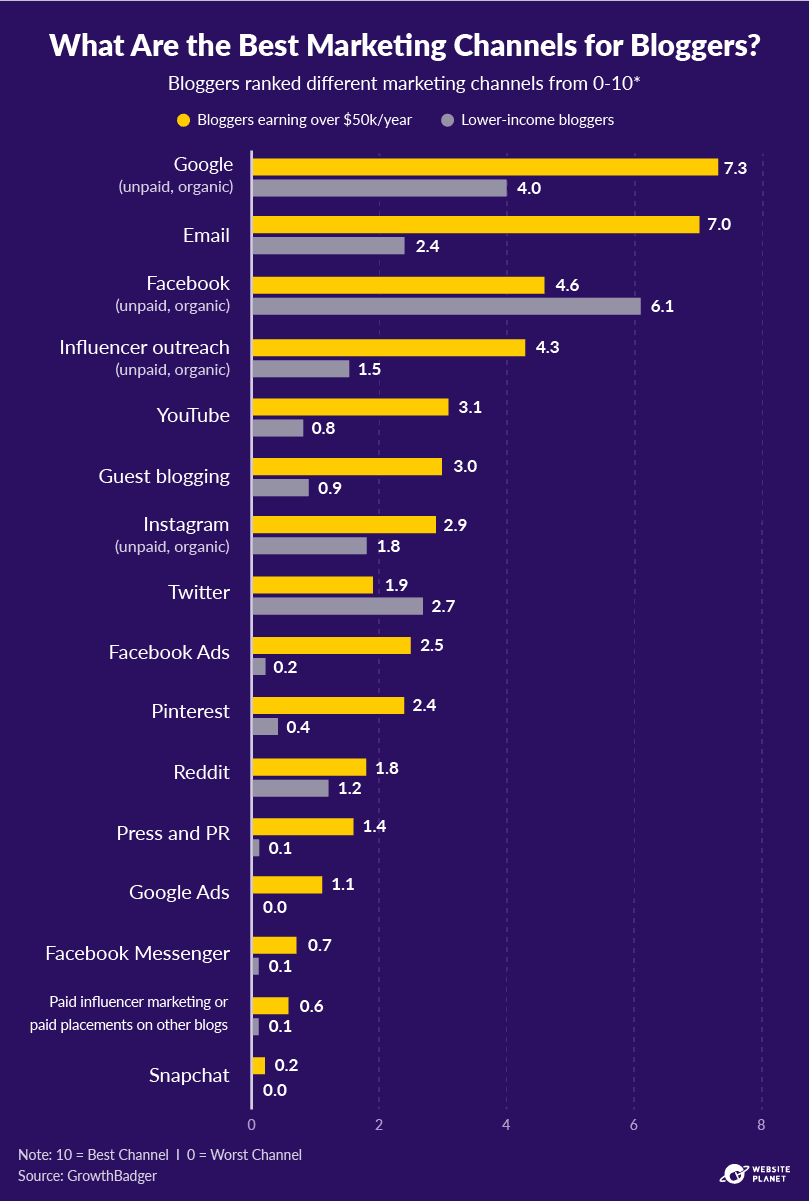 GrowthBadger asked bloggers to highlight their favorite channels for distributing blog content.
Overwhelmingly, bloggers chose organic Google traffic as the best place to push their blog. The second most popular marketing channel was email, and the third most popular channel was Facebook.
SEO is the best way to market your blog content. Why? Because Google is the primary place people go to make queries, learn information, and ultimately buy products or services.
By promoting your blog on search engines, you can drive backlinks, clicks, and traffic to your site, which will improve the trustworthiness of your blog. These are important elements if you want to create a domain that’s a stable and productive port-of-call for customers.
GrowthBadger asked bloggers to highlight their favorite channels for distributing blog content.
Overwhelmingly, bloggers chose organic Google traffic as the best place to push their blog. The second most popular marketing channel was email, and the third most popular channel was Facebook.
SEO is the best way to market your blog content. Why? Because Google is the primary place people go to make queries, learn information, and ultimately buy products or services.
By promoting your blog on search engines, you can drive backlinks, clicks, and traffic to your site, which will improve the trustworthiness of your blog. These are important elements if you want to create a domain that’s a stable and productive port-of-call for customers.
25. Which Other Forms of Content Do Bloggers Produce?
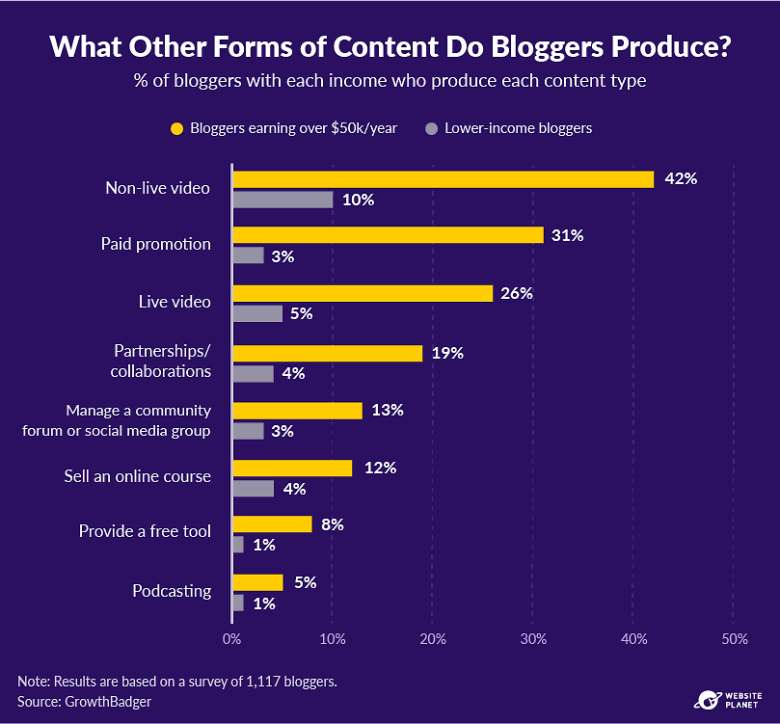 Video is a hot commodity right now, as it offers ultra-high engagement and plenty of value to the viewer. That’s why so many bloggers are including video content either within or alongside their blogs.
Video and live video rank as the first and third most important types of accompanying content for bloggers. Paid promotions are another popular form of content. They allow many bloggers and businesses to make some extra money while forging connections with other similar brands.
Video is a hot commodity right now, as it offers ultra-high engagement and plenty of value to the viewer. That’s why so many bloggers are including video content either within or alongside their blogs.
Video and live video rank as the first and third most important types of accompanying content for bloggers. Paid promotions are another popular form of content. They allow many bloggers and businesses to make some extra money while forging connections with other similar brands.
26. How Frequently Do Bloggers Publish?
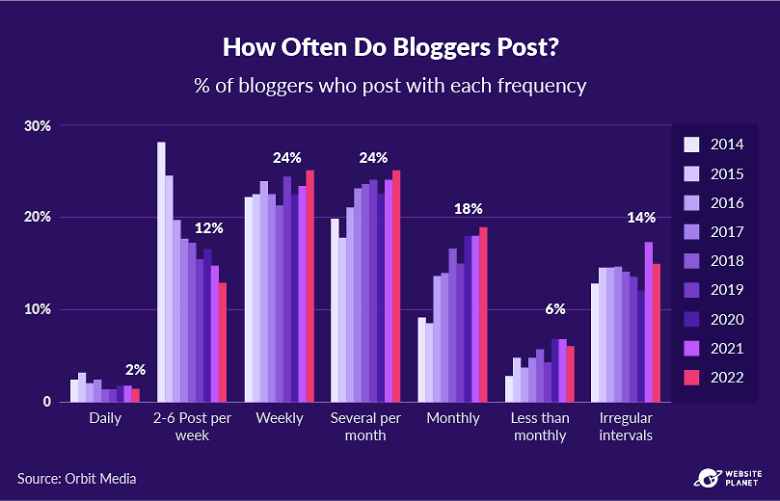 Research from Orbit Media shows that bloggers in 2022 were posting less often than they were in 2014.
2% of blogs post daily content, which is around 2% less than the figure in 2015. In 2014, nearly 30% of bloggers posted 2-6 times a week, but now that figure sits at just 12%. Meanwhile, monthly content is common among 18% of bloggers, which is greater than in previous years.
That’s kind of odd given what we know about the value of posting regular content. Businesses that publish 16 or more blog posts every month receive 3.5 X the traffic of those who only post four times or less. Daily blogs can benefit from as much as 5X more traffic than less-frequent blogs.
In part, that’s why bloggers who create a large index of posts see such fantastic results.
Research from Orbit Media shows that bloggers in 2022 were posting less often than they were in 2014.
2% of blogs post daily content, which is around 2% less than the figure in 2015. In 2014, nearly 30% of bloggers posted 2-6 times a week, but now that figure sits at just 12%. Meanwhile, monthly content is common among 18% of bloggers, which is greater than in previous years.
That’s kind of odd given what we know about the value of posting regular content. Businesses that publish 16 or more blog posts every month receive 3.5 X the traffic of those who only post four times or less. Daily blogs can benefit from as much as 5X more traffic than less-frequent blogs.
In part, that’s why bloggers who create a large index of posts see such fantastic results.
27. Businesses Should Publish on Their Blog Regularly
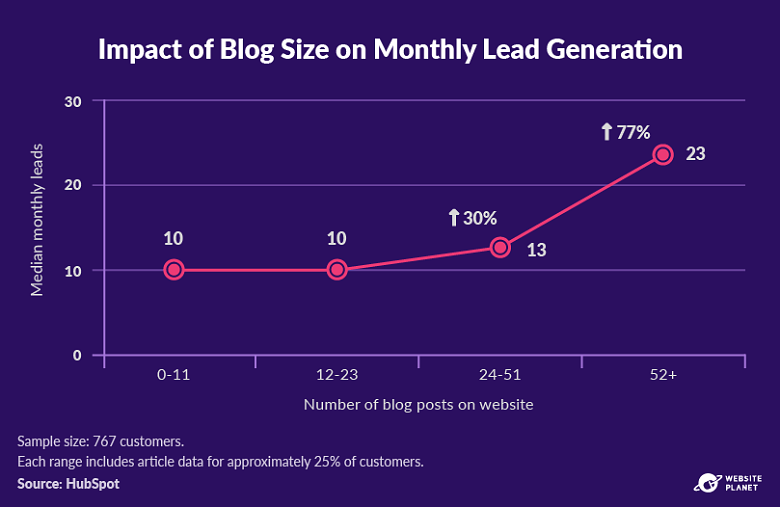 The overall size of your blog has a big impact on the popularity of your site.
Having an array of different articles helps you retain viewers on your site, for a start. If your site has many different niches, the reader is sure to find more content that they enjoy reading.
In which case, having an extensive blog works in a similar way to long-form content: your entire blog can become a valuable resource that people regularly use, revisit, and share among their friends and colleagues.
That’s why, according to HubSpot, increasing your page count by 50-100 can produce double-digit traffic growth for your blog. The same study found that websites with more than 311 Google-indexed pages can produce roughly 1400% more leads than sites with 60 pages or less.
In other words, if you add more pages and posts, you stand to profit massively in the future.
The overall size of your blog has a big impact on the popularity of your site.
Having an array of different articles helps you retain viewers on your site, for a start. If your site has many different niches, the reader is sure to find more content that they enjoy reading.
In which case, having an extensive blog works in a similar way to long-form content: your entire blog can become a valuable resource that people regularly use, revisit, and share among their friends and colleagues.
That’s why, according to HubSpot, increasing your page count by 50-100 can produce double-digit traffic growth for your blog. The same study found that websites with more than 311 Google-indexed pages can produce roughly 1400% more leads than sites with 60 pages or less.
In other words, if you add more pages and posts, you stand to profit massively in the future.
28. How Much Time Do Bloggers Spend Creating Content?
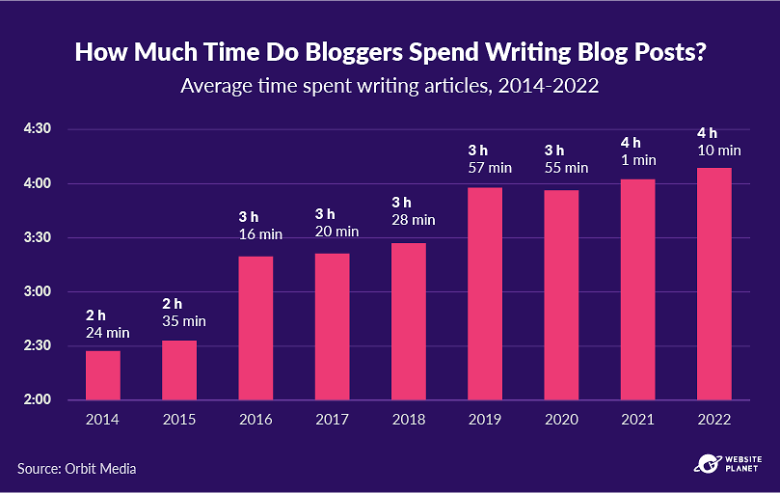 So, why are bloggers posting less frequently? The answer could lie in the graphic above.
As the posting frequency goes down, the time it’s taking to write a post goes up. Bloggers are actually spending more time writing their content than they were a few years ago.
This owes to the importance of having great research right now. In fact, Orbit Media found that the average blogger spends 4 hours and 10 minutes on a post. That’s significantly higher than the average time-per-post of 2 hours and 24 minutes in 2014.
Bloggers are spending more time on posts because quality research improves content quality, which, in turn, provides more value to the reader and gives Google more reasons to rank your page higher up.
This is why marketing agencies, businesses, and bloggers are now choosing quality over quantity when it comes to blog content.
So, why are bloggers posting less frequently? The answer could lie in the graphic above.
As the posting frequency goes down, the time it’s taking to write a post goes up. Bloggers are actually spending more time writing their content than they were a few years ago.
This owes to the importance of having great research right now. In fact, Orbit Media found that the average blogger spends 4 hours and 10 minutes on a post. That’s significantly higher than the average time-per-post of 2 hours and 24 minutes in 2014.
Bloggers are spending more time on posts because quality research improves content quality, which, in turn, provides more value to the reader and gives Google more reasons to rank your page higher up.
This is why marketing agencies, businesses, and bloggers are now choosing quality over quantity when it comes to blog content.
29. Long-Form Content Continues to Be Popular
 How long a piece should be depends on your industry, your readers’ search intent, and your goals for the content. Recent articles by industry leaders like WordPress, HubSpot, and Semrush all give similar, but slightly different, recommendations for a blog’s word count — indicating that their readership are blogging for different audiences and in different niches.
But in general, long-form content (content above 2,000 words) performs better than shorter blog posts. By providing greater value and content quality, you can bring more people to your site more often, increasing engagement, leads, and conversions.
That’s despite the fact that the average blog post is still just 1,376 words long. Top-ranking content on Google is, on average, 1300-1500 words long. But many companies find that long-form content can generate more leads and organic traffic, and make more conversions. How-to guides that perform well often have about 2,500 words. Pillar content (content that gives a broad, authoritative overview of a topic) can be successful at 4,000 words or more.
In 2014, the average blog was just 808 words long, so we’ve certainly shifted toward longer content. And that could be a valuable move for many businesses; according to Curata, long-form content creates 9X more leads than shorter-length articles.
How long a piece should be depends on your industry, your readers’ search intent, and your goals for the content. Recent articles by industry leaders like WordPress, HubSpot, and Semrush all give similar, but slightly different, recommendations for a blog’s word count — indicating that their readership are blogging for different audiences and in different niches.
But in general, long-form content (content above 2,000 words) performs better than shorter blog posts. By providing greater value and content quality, you can bring more people to your site more often, increasing engagement, leads, and conversions.
That’s despite the fact that the average blog post is still just 1,376 words long. Top-ranking content on Google is, on average, 1300-1500 words long. But many companies find that long-form content can generate more leads and organic traffic, and make more conversions. How-to guides that perform well often have about 2,500 words. Pillar content (content that gives a broad, authoritative overview of a topic) can be successful at 4,000 words or more.
In 2014, the average blog was just 808 words long, so we’ve certainly shifted toward longer content. And that could be a valuable move for many businesses; according to Curata, long-form content creates 9X more leads than shorter-length articles.
30. B2B Marketers Love to Share Blogs
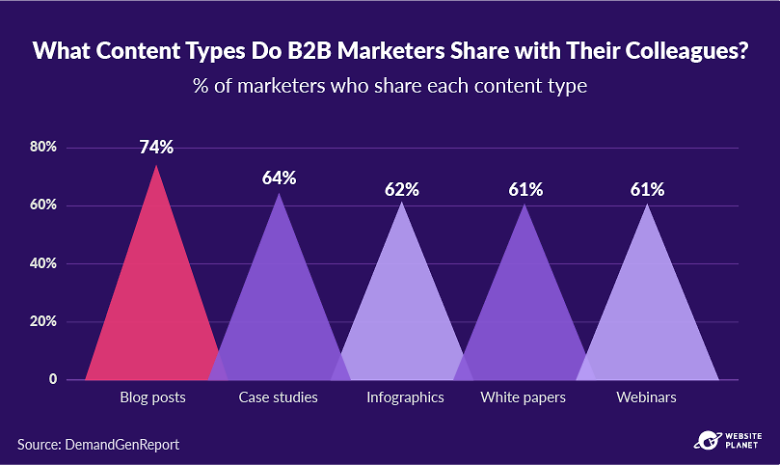 In the business-to-business world, creating leads among your peers is the name of the game. What better way to create leads than through the use of a blog?
The graphic above demonstrates how valuable educational blog content is in the B2B sector. If you can provide value to another marketer, they are likely to share your content with their peers.
This improves your chance of creating backlinks and organic traffic to your site. If your material is circulating in the right environment, it’s likely that another business will take note of what you’re saying and trust you with a purchase.
In the business-to-business world, creating leads among your peers is the name of the game. What better way to create leads than through the use of a blog?
The graphic above demonstrates how valuable educational blog content is in the B2B sector. If you can provide value to another marketer, they are likely to share your content with their peers.
This improves your chance of creating backlinks and organic traffic to your site. If your material is circulating in the right environment, it’s likely that another business will take note of what you’re saying and trust you with a purchase.
31. Analytics Are the Way Forward
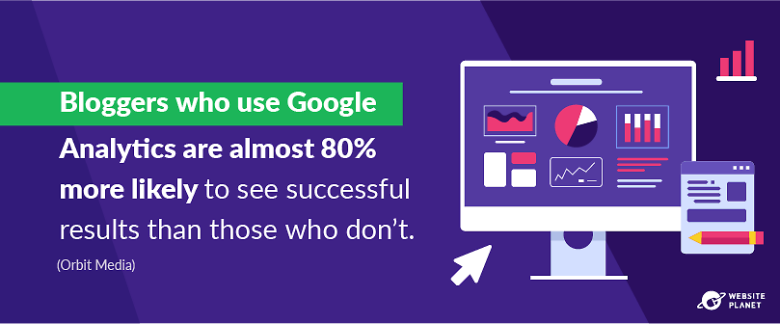 Analytics are a normal part of the process in 2025. Whether you like it or not, ignoring analytics will only hinder the success of your blogging campaigns.
Using data analysis yields results. By analyzing your blog’s data, you can know exactly how many clicks, click-throughs, and impressions each post received. Not to mention the overall traffic coming to your blog.
This helps you strategize in a couple of different ways. Analyzing your content like this means you can identify which topics are successful with your readers and which aren’t.
Analytics also means you can get a handle on your page’s presence and the success of your SEO strategy.
Adjustments here could account for huge gains in the future.
Analytics are a normal part of the process in 2025. Whether you like it or not, ignoring analytics will only hinder the success of your blogging campaigns.
Using data analysis yields results. By analyzing your blog’s data, you can know exactly how many clicks, click-throughs, and impressions each post received. Not to mention the overall traffic coming to your blog.
This helps you strategize in a couple of different ways. Analyzing your content like this means you can identify which topics are successful with your readers and which aren’t.
Analytics also means you can get a handle on your page’s presence and the success of your SEO strategy.
Adjustments here could account for huge gains in the future.
32. Marketers Should Place Visual Content on Blogs
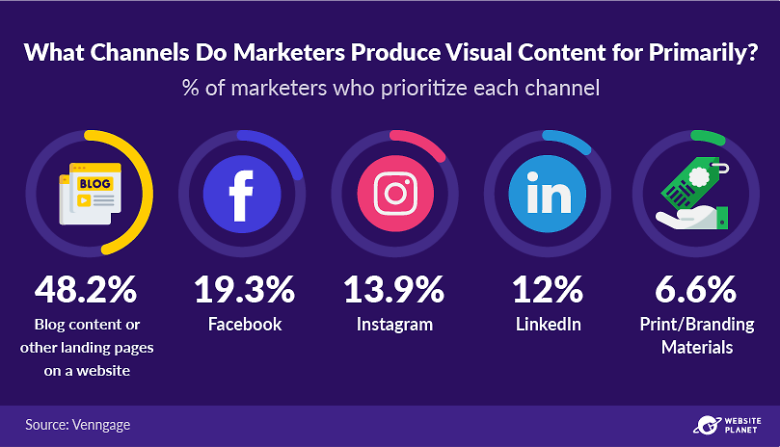 Visual content is a huge part of any business’ content marketing strategy. According to Venngage, the majority of marketers are prioritizing visual content for their blog posts.
That’s because visual content is engaging, and it increases the chances of a viewer soaking up the information you present to them.
In the same survey, Venngage found that original graphics, including infographics and illustrations, were the most common form of visual content for marketers, while stock photos ranked second.
This makes sense given the emphasis on blog content, as infographics are often the perfect accompaniment to any informative blog post.
Visual content is a huge part of any business’ content marketing strategy. According to Venngage, the majority of marketers are prioritizing visual content for their blog posts.
That’s because visual content is engaging, and it increases the chances of a viewer soaking up the information you present to them.
In the same survey, Venngage found that original graphics, including infographics and illustrations, were the most common form of visual content for marketers, while stock photos ranked second.
This makes sense given the emphasis on blog content, as infographics are often the perfect accompaniment to any informative blog post.
33. SEO Is Still an Effective Promotional Tactic
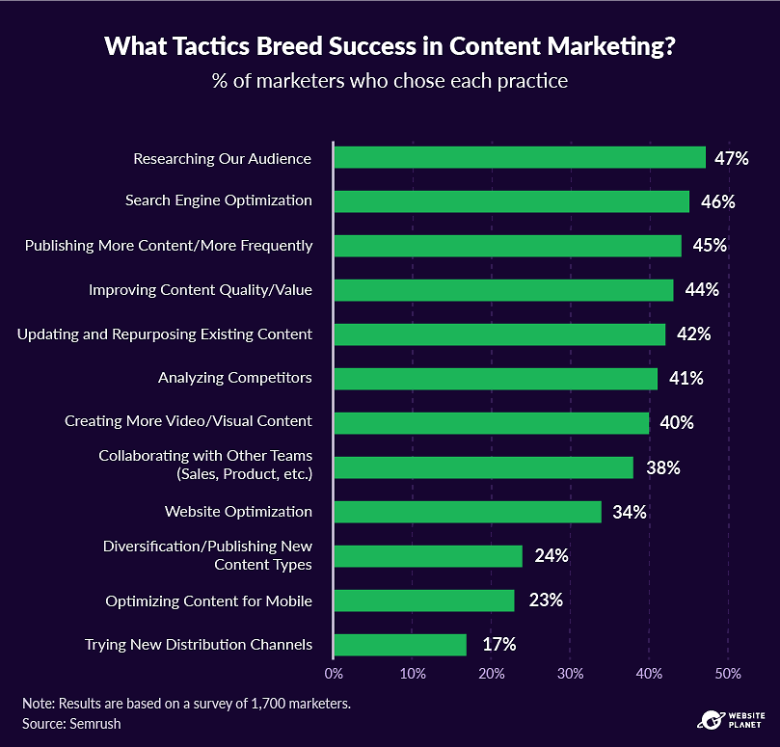 Market research and search engine optimization (SEO) are two of the most effective practices for content marketers in 2023.
According to research from Semrush, 47% of content marketers see results when they research their target audience, and another 46% of content marketers say SEO best practices bring them success.
GrowthBadger found that bloggers who earn a high income ($50k+) are 4.3X more likely to conduct SEO keyword research than lower-income bloggers.
SEO and audience research have a direct impact on blog success, which is why keyword research improves the chances of getting “strong results” by 80%.
Bloggers can optimize their content in other ways. Namely, on-page optimization can help improve SEO performance. This includes making sure your content is clear, understandable, and easy to read.
Businesses should optimize their titles, too. Optimizing your headline can increase clicks by nearly 10%.
Market research and search engine optimization (SEO) are two of the most effective practices for content marketers in 2023.
According to research from Semrush, 47% of content marketers see results when they research their target audience, and another 46% of content marketers say SEO best practices bring them success.
GrowthBadger found that bloggers who earn a high income ($50k+) are 4.3X more likely to conduct SEO keyword research than lower-income bloggers.
SEO and audience research have a direct impact on blog success, which is why keyword research improves the chances of getting “strong results” by 80%.
Bloggers can optimize their content in other ways. Namely, on-page optimization can help improve SEO performance. This includes making sure your content is clear, understandable, and easy to read.
Businesses should optimize their titles, too. Optimizing your headline can increase clicks by nearly 10%.
34. Updating Older Articles is Essential
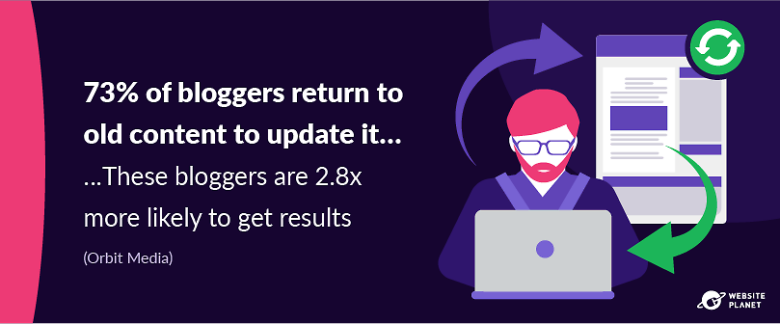 Updating older content really works, and it doesn’t take much effort.
Businesses and marketers certainly need to monitor content if they’re posting a lot of blogs that are specific to a year (like this one, for example). It’s not ideal if your content looks out-of-date. That could really damage the credibility and relevance of your blog.
What’s more, updating content with new information can actively help you rise through search engine rankings. Google will crawl your site again if you start republishing material, and you don’t even have to write anything fresh!
Updating old posts can improve their results by 280%. It’s a relatively small amount of work for a big reward.
Updating older content really works, and it doesn’t take much effort.
Businesses and marketers certainly need to monitor content if they’re posting a lot of blogs that are specific to a year (like this one, for example). It’s not ideal if your content looks out-of-date. That could really damage the credibility and relevance of your blog.
What’s more, updating content with new information can actively help you rise through search engine rankings. Google will crawl your site again if you start republishing material, and you don’t even have to write anything fresh!
Updating old posts can improve their results by 280%. It’s a relatively small amount of work for a big reward.
35. Marketers Should Recycle Content Regularly
 In a similar fashion, many marketers reuse their blog content multiple times throughout its lifecycle.
Search Engine Journal even suggests you can repurpose 1 blog post into more than 80 different types of content. You could chop your blog up into smaller sections, reuse some of its research for a similar topic, lengthen its content into an e-book, or turn it into a script for a YouTube video and podcast.
So, there’s a ton of ways to get the most out of your blog content. Repurposing content not only means you require less research to create the next piece. It also means you can create links between multiple resources on the same topic, and users can choose whether they read, watch or listen.
This will only improve the level of engagement and traffic on your site in the long run.
In a similar fashion, many marketers reuse their blog content multiple times throughout its lifecycle.
Search Engine Journal even suggests you can repurpose 1 blog post into more than 80 different types of content. You could chop your blog up into smaller sections, reuse some of its research for a similar topic, lengthen its content into an e-book, or turn it into a script for a YouTube video and podcast.
So, there’s a ton of ways to get the most out of your blog content. Repurposing content not only means you require less research to create the next piece. It also means you can create links between multiple resources on the same topic, and users can choose whether they read, watch or listen.
This will only improve the level of engagement and traffic on your site in the long run.
36. Influencers Are Also Effective
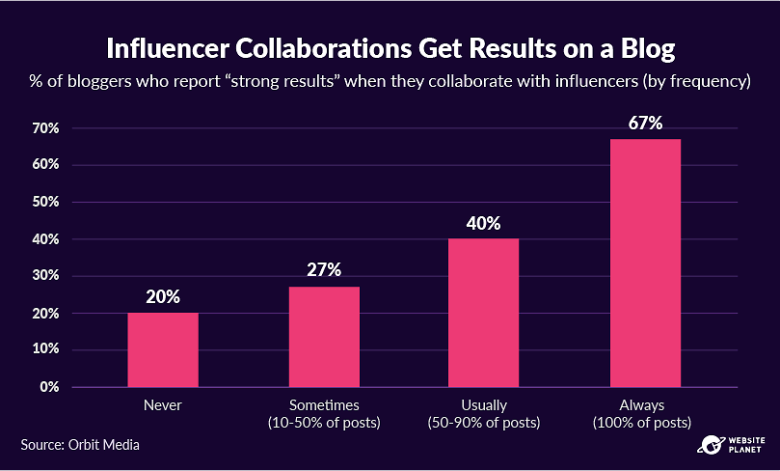 Collaborating with influencers can be a valuable part of any marketer’s strategy, yet influencer collaborations are on a downward trend.
Just 10% of bloggers collaborate with influencers. Meanwhile, only 37% of bloggers are including quotes from experts within their content.
The results bloggers get from influencer collaboration posit this as a criminally underrated strategy, particularly within the B2B world.
The influencer marketing industry is predicted to reach 21.1 billion USD in 2023. Almost 70% of respondents in Orbit Media’s study claim that they “always” get results from collaborating with influencers. Only 20% say they “never” get results.
Collaborating with influencers can be a valuable part of any marketer’s strategy, yet influencer collaborations are on a downward trend.
Just 10% of bloggers collaborate with influencers. Meanwhile, only 37% of bloggers are including quotes from experts within their content.
The results bloggers get from influencer collaboration posit this as a criminally underrated strategy, particularly within the B2B world.
The influencer marketing industry is predicted to reach 21.1 billion USD in 2023. Almost 70% of respondents in Orbit Media’s study claim that they “always” get results from collaborating with influencers. Only 20% say they “never” get results.
37. Guest Posts Are Underused For Promotion
 Similar to influencer collaborations, guest posts involve bringing in writers from other sites or niches to create content for your blog.
The majority of blogs publish guest posts at least once a month.
Perhaps bloggers should be using fresh perspectives on their blogs a little bit more often, however. Almost two-thirds of readers trust a blog site more when there are multiple writers featured.
If you want to improve the credibility of your blog, guest writers are important.
Similar to influencer collaborations, guest posts involve bringing in writers from other sites or niches to create content for your blog.
The majority of blogs publish guest posts at least once a month.
Perhaps bloggers should be using fresh perspectives on their blogs a little bit more often, however. Almost two-thirds of readers trust a blog site more when there are multiple writers featured.
If you want to improve the credibility of your blog, guest writers are important.
38. Blogging Presents Certain Challenges
 What challenges do bloggers face?
According to a survey by Orbit Media, finding enough time to research and write content is a struggle for 52% of bloggers.
Driving traffic to their website/blog is difficult for 46% of bloggers. According to a similar survey from GrowthBadger, 79% of low-income bloggers say they struggle to grow traffic to their blogs. At the same time, 70% of bloggers who earn more than $50,000/year actively promote their blogs.
This points to the dedication and persistence it takes to find success as a blogger. You’ll have to properly optimize content that provides readers with real value, while also learning how to promote your work.
What challenges do bloggers face?
According to a survey by Orbit Media, finding enough time to research and write content is a struggle for 52% of bloggers.
Driving traffic to their website/blog is difficult for 46% of bloggers. According to a similar survey from GrowthBadger, 79% of low-income bloggers say they struggle to grow traffic to their blogs. At the same time, 70% of bloggers who earn more than $50,000/year actively promote their blogs.
This points to the dedication and persistence it takes to find success as a blogger. You’ll have to properly optimize content that provides readers with real value, while also learning how to promote your work.
Elements of a Successful Business Blog
In this section, we’re going to forget about marketers for a second and focus on the content itself. We want to highlight the importance of the written word, and the best practices to really make your blog post perform.39. Prioritize Content Quality Over Quantity
 First things first, you want your content to be high quality.
According to bloggers, the quality of your content is more important than any other element, so make sure you get that right. The theme is much the same in B2B marketing. The Content Marketing Institute found that 76% of B2B marketers prioritize content quality over content quantity.
In other words, make sure you’re solving the reader’s problems and giving value with your blog. Make sure your research is accurate and that there’s plenty of it.
First things first, you want your content to be high quality.
According to bloggers, the quality of your content is more important than any other element, so make sure you get that right. The theme is much the same in B2B marketing. The Content Marketing Institute found that 76% of B2B marketers prioritize content quality over content quantity.
In other words, make sure you’re solving the reader’s problems and giving value with your blog. Make sure your research is accurate and that there’s plenty of it.
40. Do Lots of Research
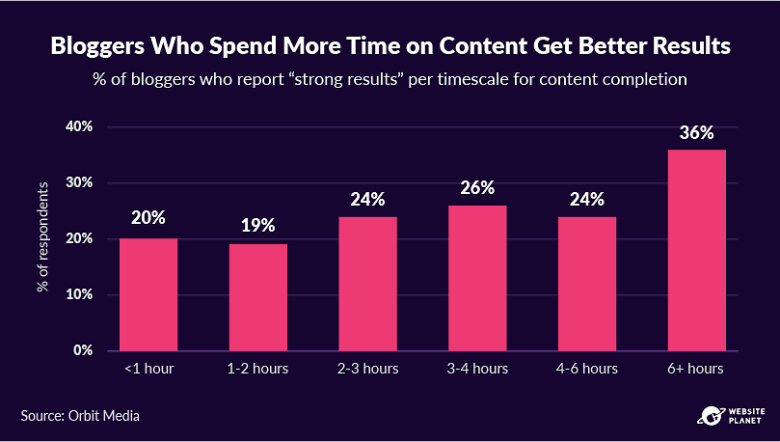 We talked earlier about the growing trend among marketers to spend more time on each project. That’s because, as this graphic shows, more work equates to better results and blog performance.
If your research is better and your content is well-written, people will enjoy reading it. You should think about adding some original research to your blogs as well.
We talked earlier about the growing trend among marketers to spend more time on each project. That’s because, as this graphic shows, more work equates to better results and blog performance.
If your research is better and your content is well-written, people will enjoy reading it. You should think about adding some original research to your blogs as well.
41. Make Your Blog Content Original
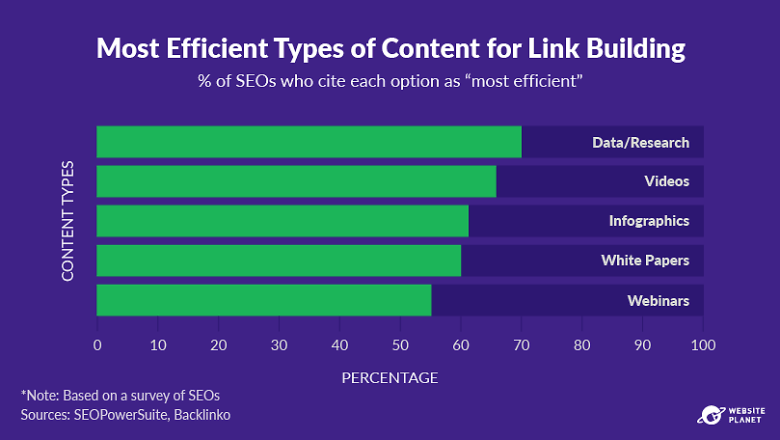 An Orbit Media survey found that 42% of bloggers used original research in 2022. That’s up from 35% in 2019, and a meager 25% in 2018.
Why? Producing original research is becoming really valuable for promoting backlinks and growing a blog. 85% of bloggers in Orbit Media’s study said original research produced “strong results.”
It’s also why SEOs rank original data/research as their number 1 content type for link building. With original research, you have the opportunity to create something completely authentic and up-to-date.
If your blog is unique, people will reference your content because no one else is providing the same kind of information. It stands to reason that the most recent data is considered the most relevant and trustworthy, too.
Ultimately, original research will drive traffic to your blog. So think about including some in your articles.
An Orbit Media survey found that 42% of bloggers used original research in 2022. That’s up from 35% in 2019, and a meager 25% in 2018.
Why? Producing original research is becoming really valuable for promoting backlinks and growing a blog. 85% of bloggers in Orbit Media’s study said original research produced “strong results.”
It’s also why SEOs rank original data/research as their number 1 content type for link building. With original research, you have the opportunity to create something completely authentic and up-to-date.
If your blog is unique, people will reference your content because no one else is providing the same kind of information. It stands to reason that the most recent data is considered the most relevant and trustworthy, too.
Ultimately, original research will drive traffic to your blog. So think about including some in your articles.
42. Create Long Content
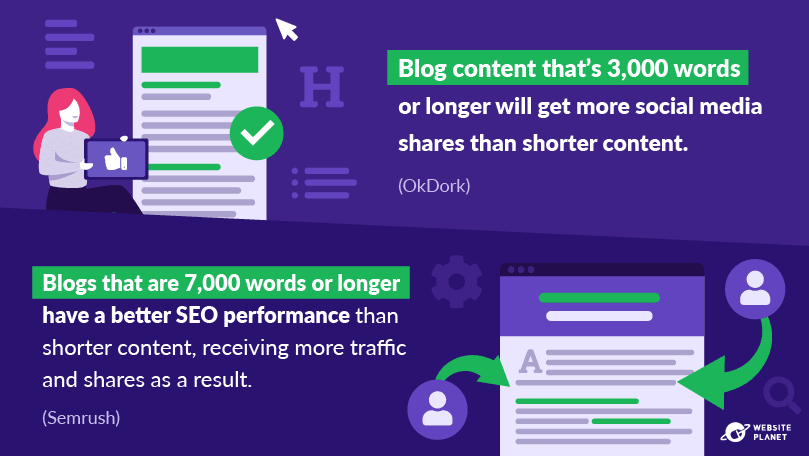 Long content provides added value to the reader. With a longer article, you can cover more topics, or go into greater detail within a particular area of discussion.
The more stuff you talk about in an article and the more comprehensive its content, the better chance you have of solving a potential customer’s problem.
That’s why 54% of bloggers who write over 3000 words per post report “strong results.” In fact, Orbit Media found that content over 3000 words is 2.5X more likely to achieve strong results than content below 500 words.
These results come in the form of shares for most long-form bloggers. By covering a topic comprehensively, you position your blog post as a resource that can be shared by readers.
Long content provides added value to the reader. With a longer article, you can cover more topics, or go into greater detail within a particular area of discussion.
The more stuff you talk about in an article and the more comprehensive its content, the better chance you have of solving a potential customer’s problem.
That’s why 54% of bloggers who write over 3000 words per post report “strong results.” In fact, Orbit Media found that content over 3000 words is 2.5X more likely to achieve strong results than content below 500 words.
These results come in the form of shares for most long-form bloggers. By covering a topic comprehensively, you position your blog post as a resource that can be shared by readers.
43. Understand Blogging and the Buyer’s Journey
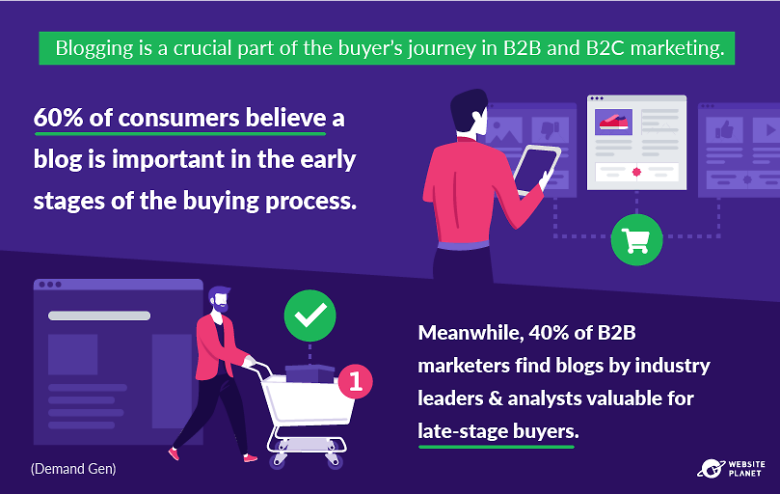 Blogging is an adaptable practice, and you can lead the reader wherever you want them to go if you’re good enough at it.
Marketing teams in different industries appear to use blogs for different parts of their buyers’ journey. Based on these statistics, blogging can be a valuable resource for B2C customers when they’re collecting information about a certain topic, product, or service.
B2B businesses, on the other hand, can use a blog packed with important information later in the buyer’s journey to get a purchase over the line.
Blogging is an adaptable practice, and you can lead the reader wherever you want them to go if you’re good enough at it.
Marketing teams in different industries appear to use blogs for different parts of their buyers’ journey. Based on these statistics, blogging can be a valuable resource for B2C customers when they’re collecting information about a certain topic, product, or service.
B2B businesses, on the other hand, can use a blog packed with important information later in the buyer’s journey to get a purchase over the line.
44. Capture the Reader’s Attention…
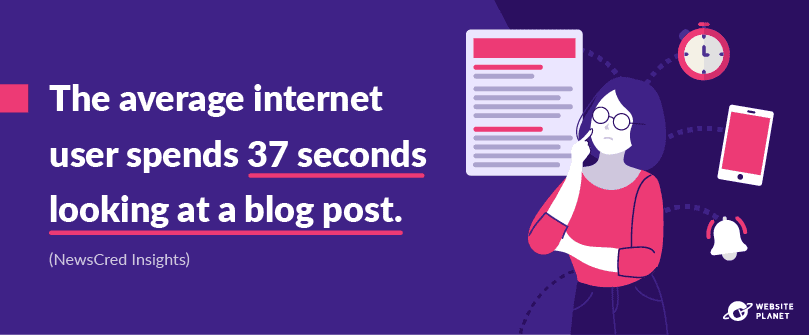 When it comes to writing content, what’s the best way to kick things off?
According to NewsCred Insights, readers spend an average of 37 seconds looking at a blog post.
That’s pretty measly, and the figure is so low because most viewers are leaving just as fast as they arrived. When writing a blog post you should remember that your readers have busy lives! They need an early affirmation that your blog will be useful to them, so make an impact right away.
That doesn’t mean you have to blast title caps and excessive punctuation at the reader for the first few lines. Write in a way that’s conversational and engaging, and tell the reader exactly what the article is about within the first few sentences. That should be enough to spike their interest.
When it comes to writing content, what’s the best way to kick things off?
According to NewsCred Insights, readers spend an average of 37 seconds looking at a blog post.
That’s pretty measly, and the figure is so low because most viewers are leaving just as fast as they arrived. When writing a blog post you should remember that your readers have busy lives! They need an early affirmation that your blog will be useful to them, so make an impact right away.
That doesn’t mean you have to blast title caps and excessive punctuation at the reader for the first few lines. Write in a way that’s conversational and engaging, and tell the reader exactly what the article is about within the first few sentences. That should be enough to spike their interest.
45. …And Make Content Skimmable
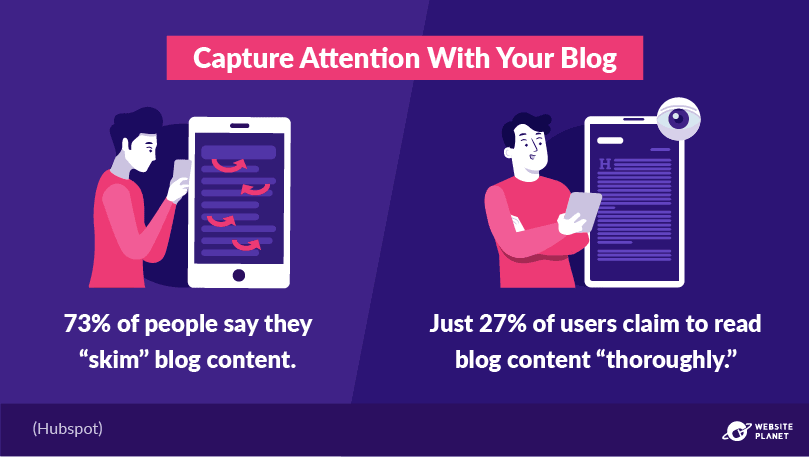 Blogs should be made skimmable. People might lose patience with an article if it’s difficult to read or overly complicated.
Big blocks of text are generally considered a bad idea. As soon as a viewer encounters a 500-word paragraph, they normally react by switching to an article where the information they want is more accessible.
Instead, write paragraphs that are just a few lines long. Keep titles concise, include bullet points and lists, and use plenty of headings. An Upland study even found that a bigger font size will make your content more accessible to readers.
Blogs should be made skimmable. People might lose patience with an article if it’s difficult to read or overly complicated.
Big blocks of text are generally considered a bad idea. As soon as a viewer encounters a 500-word paragraph, they normally react by switching to an article where the information they want is more accessible.
Instead, write paragraphs that are just a few lines long. Keep titles concise, include bullet points and lists, and use plenty of headings. An Upland study even found that a bigger font size will make your content more accessible to readers.
46. More Images = Better Results
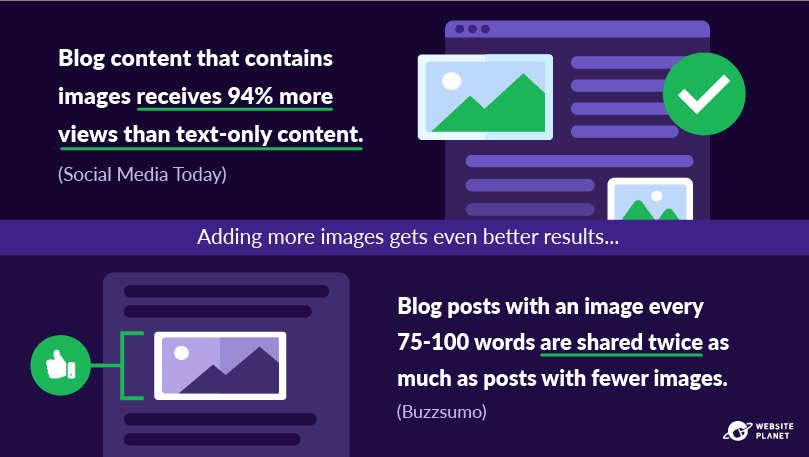 Images go hand-in-hand with blog posts, and they drive results.
Bloggers are really missing an opportunity if they’re not placing enough images in their blog posts, even if those images are stock images or photography. Adding a single image to your post will increase the number of shares it receives by 30%.
Images work so well because they create another layer of engagement for viewers. Images provide a way for visual learners to connect with the content, while they can break up heavy sections of words to make your blog content more digestible.
The more images you add the better. Orbit Media discovered that blog posts with more than 10 images have a 44% chance of achieving “strong results.” That’s twice the return compared to posts with 2-3 images.
Images go hand-in-hand with blog posts, and they drive results.
Bloggers are really missing an opportunity if they’re not placing enough images in their blog posts, even if those images are stock images or photography. Adding a single image to your post will increase the number of shares it receives by 30%.
Images work so well because they create another layer of engagement for viewers. Images provide a way for visual learners to connect with the content, while they can break up heavy sections of words to make your blog content more digestible.
The more images you add the better. Orbit Media discovered that blog posts with more than 10 images have a 44% chance of achieving “strong results.” That’s twice the return compared to posts with 2-3 images.
47. Which Visual Content Performs Best?
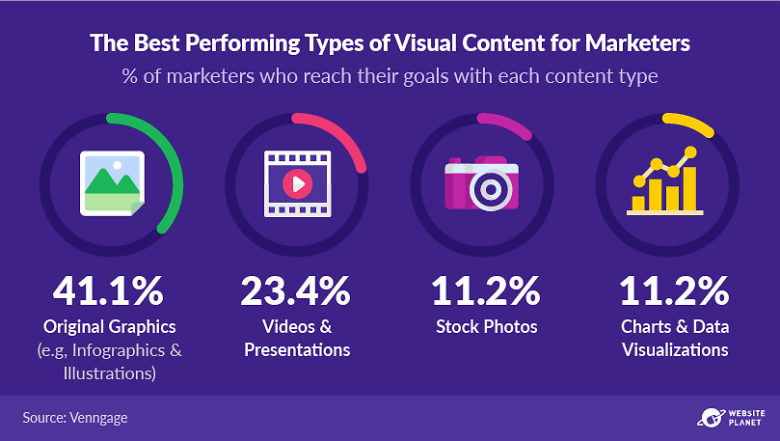 Venngage’s popular visual content study found that the top-performing type of visual content was original graphics, such as infographics and illustrations. Marketers love infographics because they can help present the information on-page in a more engaging form.
This increased engagement, along with an element of “visual learning,” makes infographics popular among marketers who blog. These 2 factors are the reason that blogs with illustrations and text inform viewers 323% better than text-only pieces.
However, only 11.2% of marketers rate stock photos as effective. Although some images are better than none, using original photos is a much more effective strategy for your blog post. Photos of real people can lead to an increase in conversions of 35% when used in place of stock photos.
Venngage’s popular visual content study found that the top-performing type of visual content was original graphics, such as infographics and illustrations. Marketers love infographics because they can help present the information on-page in a more engaging form.
This increased engagement, along with an element of “visual learning,” makes infographics popular among marketers who blog. These 2 factors are the reason that blogs with illustrations and text inform viewers 323% better than text-only pieces.
However, only 11.2% of marketers rate stock photos as effective. Although some images are better than none, using original photos is a much more effective strategy for your blog post. Photos of real people can lead to an increase in conversions of 35% when used in place of stock photos.
48. Videos Bring Significant Traffic
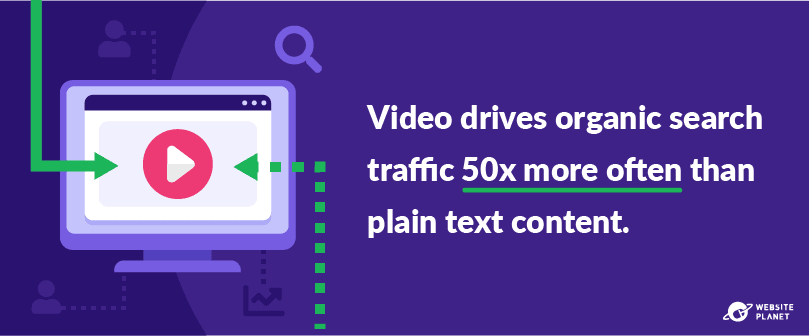 For many marketers, video is the number 1 form of content that they use in 2025. So, why not add videos to your blog posts?
As mentioned earlier, you could use the research from your blog to create a script for an accompanying video. Doing so might increase the organic traffic to your post 50-fold.
87% of marketers in a Wyzowl survey agree, stating that implementing video has increased traffic to their website. 80% also claim adding video directly increases revenue.
For many marketers, video is the number 1 form of content that they use in 2025. So, why not add videos to your blog posts?
As mentioned earlier, you could use the research from your blog to create a script for an accompanying video. Doing so might increase the organic traffic to your post 50-fold.
87% of marketers in a Wyzowl survey agree, stating that implementing video has increased traffic to their website. 80% also claim adding video directly increases revenue.
49. Draft Lots of Headlines
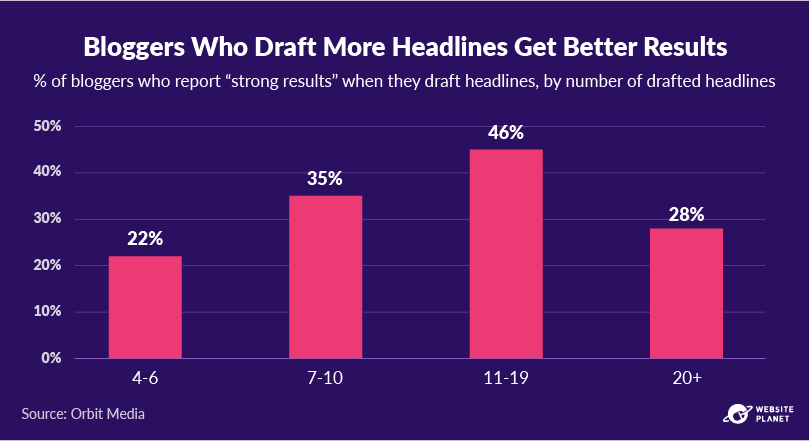 In an Orbit Media study, the vast majority (61%) of bloggers stated that they draft just 2 to 3 headlines per post. Meanwhile, only 7% of bloggers draft more than 7 headlines, and 2% of bloggers jot down 11-19 headlines.
The results suggest most marketers are cutting corners with their headlines. While a headline might not seem important, getting your headline right is crucial for the success of your post. That’s why it pays off to run through a bunch of different headline options before you publish. The sweet spot seems to be somewhere between 11 and 19 headline ideas. 46% of bloggers who drafted this many headlines saw “strong results.”
A little bit of extra time spent optimizing your headline wouldn’t go amiss, either. According to MarketingExperiments, optimizing a headline can increase post clicks by 10%.
In an Orbit Media study, the vast majority (61%) of bloggers stated that they draft just 2 to 3 headlines per post. Meanwhile, only 7% of bloggers draft more than 7 headlines, and 2% of bloggers jot down 11-19 headlines.
The results suggest most marketers are cutting corners with their headlines. While a headline might not seem important, getting your headline right is crucial for the success of your post. That’s why it pays off to run through a bunch of different headline options before you publish. The sweet spot seems to be somewhere between 11 and 19 headline ideas. 46% of bloggers who drafted this many headlines saw “strong results.”
A little bit of extra time spent optimizing your headline wouldn’t go amiss, either. According to MarketingExperiments, optimizing a headline can increase post clicks by 10%.
50. What’s the Best Headline Length?
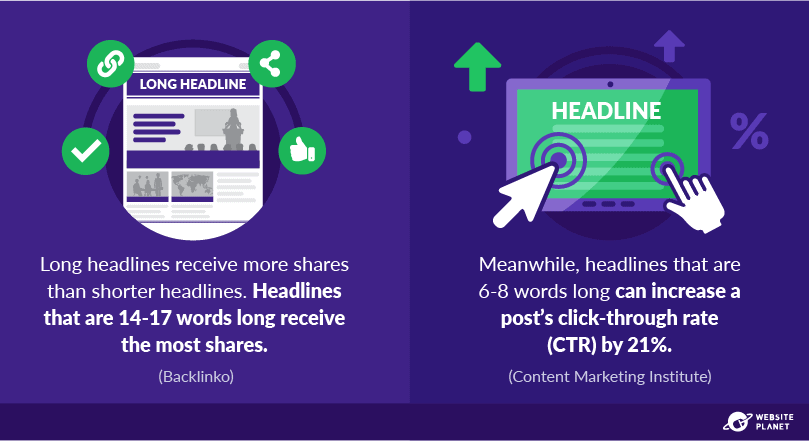 There are conflicting opinions on how long bloggers should make each post’s headline. It seems to depend entirely on the aim of your content.
Shorter headlines increase clicks while longer headlines promote more shares. The reason for that difference potentially lies behind each content type. Longer headlines outline long-form, in-depth content. Whereas shorter headlines offer quick reading and instant gratification.
HubSpot says the ideal title is 60 characters long, but whether you opt for instant impact or greater detail is ultimately up to you. Whatever you do, sneak a hyphen or colon in there somewhere. One of these two elements in a headline can increase the click-through rate by another 9%.
There are conflicting opinions on how long bloggers should make each post’s headline. It seems to depend entirely on the aim of your content.
Shorter headlines increase clicks while longer headlines promote more shares. The reason for that difference potentially lies behind each content type. Longer headlines outline long-form, in-depth content. Whereas shorter headlines offer quick reading and instant gratification.
HubSpot says the ideal title is 60 characters long, but whether you opt for instant impact or greater detail is ultimately up to you. Whatever you do, sneak a hyphen or colon in there somewhere. One of these two elements in a headline can increase the click-through rate by another 9%.
51. Top Performing Headline Styles
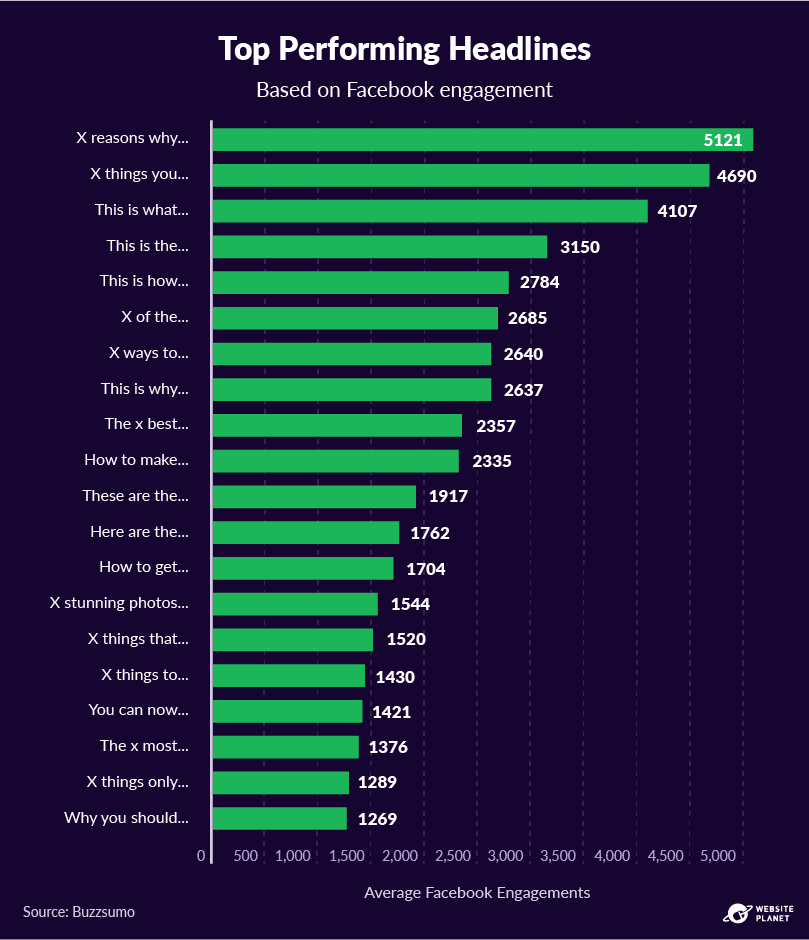 A comprehensive study from Buzzsumo tested the engagement of over 100 million different types of headlines. Specifically, there were a few phrases at the start of a headline that really stand out.
“X reasons why…” was the top-performing phrase at the beginning of a headline, with more than 5,000 shares on average. This headline was followed by “X things you…,” which received 4,700 shares on average, while “This is what…” got just over 4,000 shares.
If you’re struggling to think of ideas for a headline, choosing one of these phrases to begin your title might be a really good idea. These are proven headlines with high levels of engagement among readers.
An OkDork study also concluded that emotional headlines get more shares than non-emotional headlines, so a splash of joy or sadness could drive some extra traffic as well.
A comprehensive study from Buzzsumo tested the engagement of over 100 million different types of headlines. Specifically, there were a few phrases at the start of a headline that really stand out.
“X reasons why…” was the top-performing phrase at the beginning of a headline, with more than 5,000 shares on average. This headline was followed by “X things you…,” which received 4,700 shares on average, while “This is what…” got just over 4,000 shares.
If you’re struggling to think of ideas for a headline, choosing one of these phrases to begin your title might be a really good idea. These are proven headlines with high levels of engagement among readers.
An OkDork study also concluded that emotional headlines get more shares than non-emotional headlines, so a splash of joy or sadness could drive some extra traffic as well.
52. The Best Numbers in Headlines
 The popularity of listicles means you might want to take notice of this headline stat: it may say as much about the content people want to consume as it does about headlines.
“10” is the best performing number in an article title, garnering an average of 22,359 shares when it’s included. “5” performs pretty well, too, with over 16,000 shares per title, whereas “15” garners nearly 13,000 shares per headline.
The graphic shows that (on Facebook, at least) shorter numbers seem to perform the best.
Based on the sheer magnitude of shares these headlines get, it should come as no surprise that 31% of posts that accumulate the most click-throughs are listicles with numbers in the title.
The popularity of listicles means you might want to take notice of this headline stat: it may say as much about the content people want to consume as it does about headlines.
“10” is the best performing number in an article title, garnering an average of 22,359 shares when it’s included. “5” performs pretty well, too, with over 16,000 shares per title, whereas “15” garners nearly 13,000 shares per headline.
The graphic shows that (on Facebook, at least) shorter numbers seem to perform the best.
Based on the sheer magnitude of shares these headlines get, it should come as no surprise that 31% of posts that accumulate the most click-throughs are listicles with numbers in the title.
53. B2B Headlines Require A Different Approach
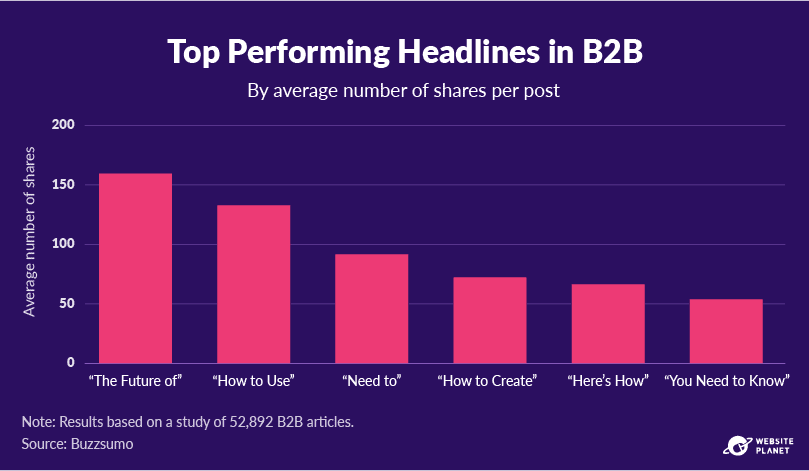 When it comes to B2B headlines, listicles are not nearly as popular as they are on your average blog. In fact, no numbered headline phrases feature in the top 5 most popular headlines.
Headlines that set the scene for an informative article still dominate, but – interestingly – predictive headlines feature far more prominently in B2B content than they do in B2C. “The future of” headlines receive more shares than any other B2B title, with just over 150 shares per article.
This suggests that B2B clients are looking to get one step ahead of the rest when they consume a blog post. This should be reflected in the type of headline (and content) that B2B bloggers ultimately choose to write.
When it comes to B2B headlines, listicles are not nearly as popular as they are on your average blog. In fact, no numbered headline phrases feature in the top 5 most popular headlines.
Headlines that set the scene for an informative article still dominate, but – interestingly – predictive headlines feature far more prominently in B2B content than they do in B2C. “The future of” headlines receive more shares than any other B2B title, with just over 150 shares per article.
This suggests that B2B clients are looking to get one step ahead of the rest when they consume a blog post. This should be reflected in the type of headline (and content) that B2B bloggers ultimately choose to write.








